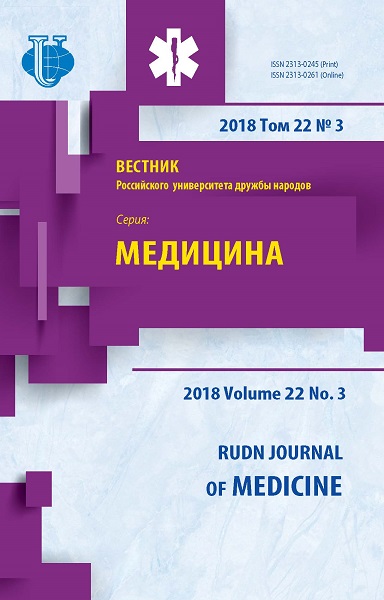SEVERE ASTHMA IN CHILDREN
- Authors: Stroikova TR1, Bashkina OA1, Mizernitskiy Y.L2, Seliverstova EN1
-
Affiliations:
- Astrakhan State Medical Univer
- Sientific Research Clinical Institute of Pediatrics. acad. Yu.E. Veltischeva
- Issue: Vol 22, No 3 (2018)
- Pages: 302-307
- Section: ALLERGOLOGY. DERMATOLOGY
- URL: https://journals.rudn.ru/medicine/article/view/19681
- DOI: https://doi.org/10.22363/2313-0245-2018-22-3-302-307
Cite item
Full Text
Abstract
The definition of severe asthma is based on the criteria for clinical control, the treatment received, as well as the response to therapy, the assessment of future risk. In severe bronchial asthma, control can be achieved only at the highest possible level of therapy, namely, in treatment corresponding to the 4th or 5th stage. The article highlights the features of the clinical phenotype of severe bronchial asthma in children. Purpose: to identify the predictors of severe phenotype in children, the analysis of clinical and anamnestic features, to study the dynamics of disease control. Materials and methods: a group of patients with different degrees of severity of bronchial asthma aged 3 to 12 years, both sexes, was studied. The clinical aspects of the disease, the dynamics of control over bronchial asthma have been studied. Functional tests were carried out: examination of the function of external respiration, pyclofometry. Data of a specific allergic diagnosis (skin tests with non-bacterial allergens, detection of specific IgE antibodies), self-monitoring tests were studied. Statistical methods used a nonparametric method, a c2 distribution, a Pearson test, using conjugacy tables. Results and discussion: the family female phenotype is a predictor of severe bronchial asthma in patients in this group. The severity of the disease on the background of therapy for five years in a group of patients was revised only in a third of children. With this phenotype, partial control over the disease was achieved. The ineffectiveness of control is associated with the presence of a comorbid background: the pathology of the nervous system, the gastrointestinal tract, endocrine disorders. The severe phenotype of bronchial asthma, independently of age debut, was significantly less frequent than in the case of moderate disease.
Keywords
About the authors
T R Stroikova
Astrakhan State Medical Univer
Author for correspondence.
Email: mega.astor@mail.ru
O A Bashkina
Astrakhan State Medical Univer
Email: mega.astor@mail.ru
Yu L Mizernitskiy
Sientific Research Clinical Institute of Pediatrics. acad. Yu.E. Veltischeva
Email: mega.astor@mail.ru
E N Seliverstova
Astrakhan State Medical Univer
Email: mega.astor@mail.ru
References
- Vishnyova E.A., Namazova-Baranova L.S., Alekseeva A.A., EHfendieva K.E., Levina YU.G., Voznesenskaya N.I., Tomilova A.YU., Selimzyanova L.R., Promyslova E.A. Pediatric asthma: key principles of achieving control at the present stage. Pediatric Pharmacology. 2013;10(4):60—72.
- National program “Bronchial asthma in children. The strategy of treatment and prevention”. 5th edition, revised and supplemented. Moscow: Russian Respiratory Society, 2017. 159 р.
- Baranov A.A., Dzhumagaziev A.A., Bezrukova D.A. Pathogenetic foundations of atopic pathology in children. Astrakhan Medical Journal. 2010. T. 5. № 1. Р. 7—11.
- Nenasheva N.M. Phenotypes of bronchial asthma and choice of therapy. Practical pulmonology. 2014. № 2. Р. 2—11.
- Trofimov V.I., Mineev V.N., Mironova Zh.A., Sorokina L.N., Korostovtsev D.S. Age features of severe uncontrolled bronchial asthma in children and adults. Medical Council. 2016. № 15. Р. 28—32.
- Miczkevich S.E. Phenotypes of bronchial asthma in children and differentiated tactics and Treatment. Bulletin of the Chelyabinsk State University. 2014. № 4. Р. 79—85.
- Anderson G.P. Endotyping asthma: new insights into key pathogenic mechanisms in a complex, heterogeneous disease. Lancet. 2008;372:1107—19.
- Kamaev А.V., Parshutkina O.Y. Risk factors for severe bronchial asthma in children. Аllergology. 2005. № 1. Р. 3—7.
- Fedoseev G.B. Many-faced bronchial asthma — phenotypes and clinico-pathogenetic variants / Trofimov V.I., Shailieva L.O., Eliseeva M.V., Kryakunov K.N. Russian Allergo-Logical Journal. 2012. № 1. P. 50—57.
- Wenzel S. Severe asthma: from characteristics to phenotypes to endotypes. Clinical and Experimental Allergy. 2012;42:650—658.
- Kurbacheva O.M, Pavlova K.S., Kozulina I.E. A Modern approach to the choice of therapy of bronchial asthma: from clinical phenotypes to practical aspects. Russian Medical Journal. 2013. № 29. Р. 1452.
- Сhuchalin A.G., Ogorodova L.M., Petrovsky F.I., Zhestkov A.V. Basic therapy of severe bronchial asthma. Data from the National Study of NABAT. Pulmonology. 2004. № 6. P. 32—37.
- Nenasheva N.M. Possibilities of therapy of severe bronchial asthma: reality and prospects. Мedical advice. 2013. № 6. Р. 11—15.
- Astafyeva N.G., Gamova I.V., KobzevY.U. Difficulties in diagnosing and treating bronchial asthma in children of the first five years of life. Doctor in charge. 2011. № 1. Spec. no. P. 1—8.
- Ogorodova L.M., Petrovsky F.I. Pharmacotherapy of severe bronchial asthma in children: attention to inhaled steroids. Pediatric Pharmacology. 2011. № 6. Р. 40—48.
















